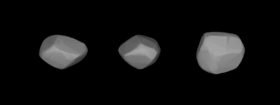astro.wikisort.org - Asteroid
Angelina (minor planet designation: 64 Angelina) is an asteroid from the central region of the asteroid belt, approximately 50 kilometers in diameter. It is an unusually bright form of E-type asteroid.
 Lightcurve-based 3D-model of Angelina | |
| Discovery | |
|---|---|
| Discovered by | Ernst Wilhelm Tempel |
| Discovery date | March 4, 1861 |
| Designations | |
MPC designation | (64) Angelina |
| Pronunciation | /ˌændʒəˈliːnə/ AN-jə-LEE-nə[1] |
Minor planet category | Main belt[2] |
| Adjectives | Angelinian (/ˌændʒəˈlɪniən/ AN-jə-LIN-nee-ən) |
| Orbital characteristics | |
| Epoch December 31, 2006 (JD 2454100.5) | |
| Aphelion | 451.375 Gm (3.017 AU) |
| Perihelion | 351.784 Gm (2.352 AU) |
Semi-major axis | 401.580 Gm (2.684 AU) |
| Eccentricity | 0.124 |
Orbital period (sidereal) | 1606.452 d (4.40 yr) |
Mean anomaly | 107.758° |
| Inclination | 1.308° |
Longitude of ascending node | 309.285° |
Argument of perihelion | 179.641° |
| Physical characteristics | |
| Dimensions | 48 x 53 km[3] 52 ± 10 km[4] 60 x 53 x 45 km[5] |
| Mass | 1.5×1017 kg (assumed)[6] |
Synodic rotation period | 8.752 hr[2] (0.365 d) |
Geometric albedo | 0.28 [7] 0.157 (IRAS)[2] |
Spectral type | E |
Absolute magnitude (H) | 7.67 [2] |
Discovery and naming
Angelina was discovered on March 4, 1861, by a prolific comet discoverer, E. W. Tempel, observing from Marseilles, France. It was the first of his five asteroid discoveries.
The naming of Angelina caused some controversy. It was chosen by Benjamin Valz, director of the Marseilles Observatory, in honour of the astronomical station of that name operated by Baron Franz Xaver von Zach on the mountains above the city. At the time, asteroids were supposed to receive names from classical mythology, and several astronomers protested the choice. Tempel noted that if the second 'n' were removed, the complaints would be satisfied (referring to Angelia, a minor Greek deity). However, Valz's choice stayed.[8]
Physical characteristics
Angelina is an uncommon form of E-type asteroid; it is the third largest E-type after 44 Nysa and 55 Pandora, and has an exceptionally high albedo.[9] As of 1991, it is thought to have an average radius of about 30 kilometers (19 mi).[10] Back when asteroids were generally assumed to have low albedos, Angelina was thought to be the largest of this class, but modern research has shown that its diameter is only a quarter of what was previously assumed, an error caused by its exceptional brightness. Traditional calculations had suggested that since Angelina has an absolute magnitude of 7.7 and an albedo of 0.15,[2] its diameter would have been around 100 km. However, a 2004 occultation showed a cross-sectional profile of only 48x53 km.[3] Angelina was observed by Arecibo radar in January 2010.[5]
References
- "Angelina". Oxford English Dictionary (Online ed.). Oxford University Press. (Subscription or participating institution membership required.)
- "JPL Small-Body Database Browser: 64 Angelina". Retrieved 5 September 2010.
2010-06-01 last obs
- David Dunham (2–3 July 2004). "IOTA Meeting, Apple Valley, Calif". IOTA. Retrieved 21 February 2007.
- Ďurech, Josef; Kaasalainen, Mikko; Herald, David; Dunham, David; Timerson, Brad; Hanuš, Josef; et al. (2011). "Combining asteroid models derived by lightcurve inversion with asteroidal occultation silhouettes" (PDF). Icarus. 214 (2): 652–670. arXiv:1104.4227. Bibcode:2011Icar..214..652D. doi:10.1016/j.icarus.2011.03.016. S2CID 119271216. Archived from the original (PDF) on 3 March 2016. Retrieved 26 January 2012.
- Shepard, Michael K.; Harris, Alan W.; Taylor, Patrick A.; Clark, Beth Ellen; Ockert-Bell, Maureen; Nolan, Michael C.; et al. (2011). "Radar observations of Asteroids 64 Angelina and 69 Hesperia" (PDF). Icarus. 215 (2): 547–551. arXiv:1104.4114. Bibcode:2011Icar..215..547S. doi:10.1016/j.icarus.2011.07.027. S2CID 119290080.
- Using a spherical radius of 26 km; volume of a sphere * density of 2 g/cm3 yields a mass (m=d*v) of 1.472E+17 kg
- Morrison, D.; Chapman, C. R. (1976). "Radiometric diameters for an additional 22 asteroids". Astrophysical Journal. 204: 934–939. Bibcode:1976ApJ...204..934M. doi:10.1086/154242.
- Schmadel, Lutz D. (2003). Dictionary of Minor Planet Names. Springer Science & Business Media. p. 21. ISBN 978-3-540-00238-3.
- Kiselev, N.N; Shakhovskoy, N.M; Efimov, Yu.S (1996), "On the Polarization Opposition Effect of E-Type Asteroid 64 Angelina", Icarus, 120 (2): 408, Bibcode:1996Icar..120..408K, doi:10.1006/icar.1996.0060
- Lionel Wilson and Klaus Keil - Explosive Eruptions on Asteroids: The Missing Basalts on the Aubrite Parent Body - Abstracts of the Lunar and Planetary Science Conference, volume 22, page 1515, (1991)
External links
- 2004 Angelina occultation (cross-sectional profile of 48x53 km)
- 64 Angelina at AstDyS-2, Asteroids—Dynamic Site
- 64 Angelina at the JPL Small-Body Database
На других языках
[de] (64) Angelina
(64) Angelina ist ein Asteroid des mittleren Hauptgürtels und wurde nach der Privatsternwarte des Astronomen Franz Xaver von Zach nahe Marseille benannt. Angelina gehört zu einer seltenen Klasse von Asteroiden, deren Oberfläche sich aus dem Mineral Enstatit zusammensetzt.- [en] 64 Angelina
[es] (64) Angelina
(64) Angelina es un asteroide perteneciente al cinturón de asteroides descubierto por Ernst Wilhelm Leberecht Tempel el 4 de marzo de 1861 desde el observatorio de Marsella, Francia. Está nombrado por la estación astronómica Notre-Dame-des-Anges, cercana a Marsella, propiedad del barón Franz Xaver von Zach (1754-1832).[2][ru] (64) Ангелина
(64) Ангелина (нем. Angelina) — астероид главного пояса, принадлежащий к яркому спектральному классу E. Он был открыт 4 марта 1861 года немецким астрономом Эрнстом Темпелем в Марсельской обсерватории (это был первый из пяти открытых им астероидов) и назван в честь Ангелины, обсерватории барона Франца Ксавера фон Цаха, которая располагалась вблизи Марселя. Подобный выбор был подвергнут резкой критике со стороны немецких и британских астрономов, в частности, Джона Гершеля и Джорджа Эйри, поскольку для именования астероидов традиционно использовались имена мифологических персонажей. Тем не менее, астероиду всё же было присвоено наименование, предложенное Цахом[6].Другой контент может иметь иную лицензию. Перед использованием материалов сайта WikiSort.org внимательно изучите правила лицензирования конкретных элементов наполнения сайта.
WikiSort.org - проект по пересортировке и дополнению контента Википедии